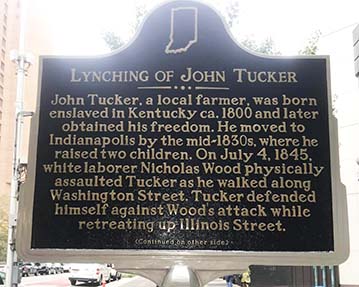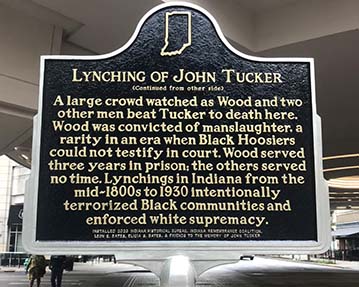Lynching of John Tucker


Location: 110 W Washington St., Indianapolis (Marion County), Indiana 46204
Installed 2023 Indiana Historical Bureau, Indiana Remembrance Coalition, Leon E. Bates, Elicia S. Bates, & Friends to the Memory of John Tucker
ID#: 49.2023.3
Text
Side One
John Tucker, a local farmer, was born enslaved in Kentucky ca. 1800 and later obtained his freedom. He moved to Indianapolis by the mid-1830s, where he raised two children. On July 4, 1845, white laborer Nicholas Wood physically assaulted Tucker as he walked along Washington Street. Tucker defended himself against Wood’s attack while retreating up Illinois Street.
Side Two
A large crowd watched as Wood and two other men beat Tucker to death here. Wood was convicted of manslaughter, a rarity in an era when Black Hoosiers could not testify in court. Wood served three years in prison; the others served no time. Lynchings in Indiana from the mid-1800s to 1930 intentionally terrorized Black communities and enforced white supremacy.
Annotated Text
Side One
Lynching of John Tucker
John Tucker, a local farmer, was born enslaved in Kentucky ca. 1800 and later obtained his freedom.[1] He moved to Indianapolis by the mid-1830s, where he raised two children.[2] On July 4, 1845, white laborer Nicholas Wood physically assaulted Tucker as he walked along Washington Street.[3] Tucker defended himself against Wood’s attack while retreating up Illinois Street.[4]
Side Two
Lynching of John Tucker
A large crowd watched as Wood and two other men beat Tucker to death here.[5] Wood was convicted of manslaughter, a rarity in an era when Black Hoosiers could not testify in court.[6] Wood served three years in prison; the others served no time.[7] Lynchings in Indiana from the mid-1800s to 1930 intentionally terrorized Black communities and enforced white supremacy.[8]
*Learn more about the life and death of John Tucker with the Indiana History Blog.
Note: Although lynchings are often thought of as hangings, institutions like the Jim Crow Museum, NAACP, Lynching Sites Project, and the Texas State Historical Association (TSHA), as well as standard dictionaries and encyclopedias, note that they include any act of homicidal violence perpetrated by a mob. The TSHA notes that the perpetrators kill “under the pretext of service to justice, race, or tradition.”
[1] “Affray and Murder,” Indiana State Sentinel, July 10, 1845, 1, accessed Hoosier State Chronicles; Gayle Thornbrough and Dorothy L. Riker, eds., The Diary of Calvin Fletcher, vol. III, 1844-1847 (Indianapolis: Indiana Historical Society, 1974), 164.
[2] “Affray and Murder,” Indiana State Sentinel, July 10, 1845, 1, accessed Hoosier State Chronicles, 5; Gayle Thornbrough and Dorothy L. Riker, eds., The Diary of Calvin Fletcher, vol. III, 1844-1847 (Indianapolis: Indiana Historical Society, 1974), 164; “John Tucker,” General Index of Estates, No. 512, July 23, 1845, II-96, emailed to IHB by Indiana Archives and Records Administration Reference Archivist, Keenan Salla; H.W. Beecher, “Rev. H. W. Beecher—the Indianapolis Murder,” Indiana State Sentinel, July 30, 1845, 2, accessed Newspapers.com; Petition to Sell Paid Real Estate as Insolvent, John Tuckers Estate, George H.P. Henderson, Adm of the Estate of John Tucker, Deceased v.s. Mary Tucker & William Tucker, Infants, Thursday October 16th 1845, and 4th Day of Term, emailed to IHB by Indiana Archives and Records Administration Reference Archivist, Keenan Salla; George H. P. Henderson, Adm. of the Estate of John Tucker v. Elizabeth Frazee, of Full Age, & Meary Tucker and William Tucker (infants), Saturday, August 23rd, A.D., 1851 & 12th Day of the Term, emailed to IHB by Indiana Archives and Records Administration Reference Archivist, Keenan Salla; Ruling on the Estate of John Tucker, Saturday, August 23rd A.D. 1851 + 10th Day of the Term, sent to the author from archivist Keenan Salla, Indiana State Archives.
[3] “Affray and Murder,” Indiana State Sentinel, July 10, 1845, 1, accessed Hoosier State Chronicles; H.W. Beecher, “Rev. H. W. Beecher—the Indianapolis Murder,” Indiana State Sentinel, July 30, 1845, 2, accessed Newspapers.com; “Marion Circuit Court: Criminal Cases,” Indiana State Sentinel, August 13, 1845, 2, accessed Newspapers.com; State vs. Nicholas Wood, Box 045, Folder 081, Location 53-S-6, Accession 2007236, AAIS 116220, Reference COURT0012595, Indiana State Archives, courtesy of historian Leon Bates; W.R. Holloway, Indianapolis: A Historical and Statistical Sketch of the Railroad City, a Chronicle of Its Social, Municipal, Commercial and Manufacturing Progress, with Full Statistical Tables (Indianapolis: Indianapolis Journal Print., 1870), 80-81, accessed Archive.org.
[4] “Affray and Murder,” Indiana State Sentinel, July 10, 1845, 1, accessed Hoosier State Chronicles; Testimony of Enoch Pyle, State vs. Nicholas Wood, William Ballinger + Edward Davis, Box 045, Folder 081, Location 53-S-6, Accession 2007236, AAIS 116220, Reference COURT0012595, Indiana State Archives, courtesy of historian Leon Bates; H.W. Beecher, “Rev. H. W. Beecher—the Indianapolis Murder,” Indiana State Sentinel, July 30, 1845, 2, accessed Newspapers.com.
[5] “Affray and Murder,” Indiana State Sentinel, July 10, 1845, 1, accessed Hoosier State Chronicles; H.W. Beecher, “Rev. H. W. Beecher—the Indianapolis Murder,” Indiana State Sentinel, July 30, 1845, 2, accessed Newspapers.com; Testimony of Enoch Pyle, State vs. Nicholas Wood, William Ballinger + Edward Davis, Box 045, Folder 081, Location 53-S-6, Accession 2007236, AAIS 116220, Reference COURT0012595, Indiana State Archives, courtesy of historian Leon Bates; “Marion Circuit Court: Criminal Cases,” Indiana State Sentinel, August 13, 1845, 2, accessed Newspapers.com
[6] “Marion Circuit Court,” Indiana State Sentinel, August 20, 1845, 2, accessed Newspapers.com; The Locomotive (Indianapolis), August 23, 1845, 2, accessed Hoosier State Chronicles; “James Overall,” historical marker notes, 2016, accessed Indiana Historical Bureau.
[7] State vs. Nicholas Wood, William Ballinger + Edward Davis, July 7th 1845, courtesy of Leon Bates; Gayle Thornbrough and Dorothy L. Riker, eds., The Diary of Calvin Fletcher, vol. III, 1844-1847 (Indianapolis: Indiana Historical Society, 1974), 164-165; The Locomotive, August 16, 1845, 2, accessed Hoosier State Chronicles; “Marion Circuit Court,” Indiana State Sentinel, August 20, 1845, 2, accessed Newspapers.com; “Murder Cases at Indianapolis,” Evansville Weekly Journal, August 28, 1845, 2, accessed Newspapers.com; Indiana State Prison South, Pardon Book B, page 20, microfilm roll 1, 401-F-2, DOC000690, ICPR Digital Archives, courtesy of historian Leon Bates; “Nicholas Woods,” Descriptive List of the Convicts in the State Prison of Indiana, at Jeffersonville, Pardoned Aug. 20th, 1848, Indiana State Archives and Records Administration, courtesy of historian Leon Bates; W.R. Holloway, Indianapolis: A Historical and Statistical Sketch of the Railroad City, a Chronicle of Its Social, Municipal, Commercial and Manufacturing Progress, with Full Statistical Tables (Indianapolis: Indianapolis Journal Print., 1870), 80-81, accessed Archive.org.
[8] “Wrong,” Indiana State Sentinel, August 28, 1845, 2, accessed Newspapers.com; Equal Justice Initiative, Lynching in America: Confronting the Legacy of Racial Terror, Third Edition (Montgomery, AL: Equal Justice Initiative, 2017), passim.
Keywords
African American; Law & Court
